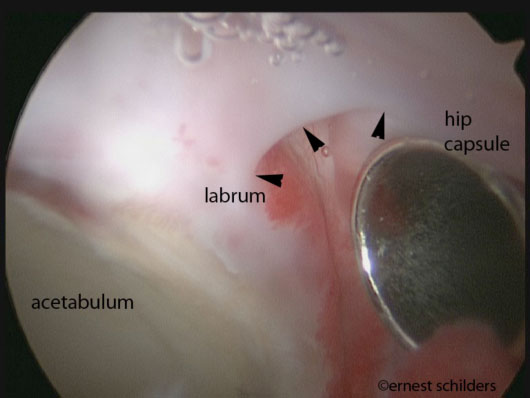 |
For more information call
The Wellington Hospital: 020 7483 5589
Fortius Clinic: 0845 853 1000 The Yorkshire Clinic: 01274 621600 |
Revision Hip Arthroscopy
With the number of surgeons performing hip arthroscopy dramatically increasing, the number of revisions or repeat surgery, unfortunately, is increasing as well.
Complex hip arthroscopy has a very steep learning curve, which makes it difficult for the novice in arthroscopy to master all the aspects of this type of surgery at once.
The main indications for repeat surgery are ongoing pain due to incomplete treatment for hip impingement and adhesions (scar tissue formation).

(arthroscopic picture showing a band of scar tissue (arrows) between the labrum and the capsule)
A good guide for successful surgery postoperatively is the disappearing of the pain you had before the procedure. This does not imply that you will be pain free immediately postoperatively and there is some pain or discomfort to be expected that can last up to 6 months but gradually reduces, but more rapidly in the first 2 months.
Professor Schilders sees patients for second opinions regularly for failed hip arthroscopic surgery and in the first instance it is important to understand why there is still ongoing pain. It is important that patients have the correct expectations following surgery, and somebody with significant arthritis is to be expected to have ongoing pain symptoms similarly to the preoperative status. With repeat X rays or sometimes with a 3D CT reconstruction scan we can assess if there has been sufficient decompression of cam and pincer lesions during the arthroscopy. None of these tests are dynamic assessments and therefore nothing can replace the dynamic assessment intraoperatively done by an experienced hip arthroscopist.
A common finding also in repeat hip arthroscopy are untreated labral tears and untreated articular cartilage lesions.
Unfortunately even experienced surgeons might have to do repeat hip arthroscopies. Adhesions or scar tissue formation are the main indication. The risk for adhesions increases with the complexity of the procedure and to avoid this early range of motion exercises are imperative. This complication occurs in less than 1 % of the hip arthroscopies. Our rehab program is designed to initiate early range of motion exercises from the day after surgery to avoid adhesions.
Professor Schilders has had very good outcomes with the majority of high level athletes being able to return to their preinjury level.